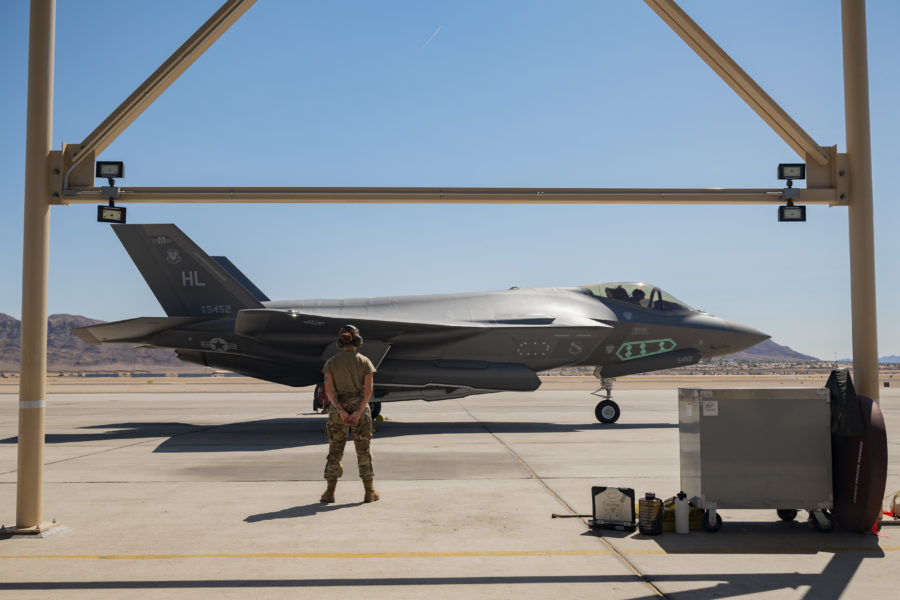A new report from a study group organized by the Lawrence Livermore National Laboratory hopes to shape a crucial emerging debate in Washington: how to manage two nuclear near-peers for the first time in U.S. history.
“This new problem compels a broad rethinking of the assumptions of U.S. nuclear policy and of the deterrence practices of the United States,” write the authors of the report, which include former senior defense and nuclear policy officials.
Some of the group’s proposals have bipartisan support and are already underway. It argues the U.S. should invest in the modernization of the nation’s nuclear triad by certifying the F-35 Lightning II stealth fighter as a dual-capable aircraft—capable of carrying conventional and nuclear weapons—by 2024, fielding a significant number of new B-21 Raider stealth bombers, and ensuring the Sentinel intercontinental ballistic missile is fielded to replace the aging Minuteman III.
The study, however, argues for additional steps, including consideration of increasing the number of U.S. nuclear forces to boost their chances of surviving an enemy attack.
It also says policymakers should consider some hotly-debated ideas the Biden administration has shot down, such as fielding attack submarines with the nuclear Sea-Launched Cruise Missile (SLCM-N), which the Pentagon does not plan to develop despite Congressional pushback by Republican lawmakers, and exploring a mobile variant of the Air Force’s Sentinel ICBM.
“The United States should also seriously explore making a portion of the ICBM force road-mobile (but garrison-based), and take steps to ensure that the Sentinel ICBM can be made mobile in the future if necessary,” the report states. “This enhances the survivability of the ICBM force without increasing the need to consider launch under attack and hedges against a breakthrough in anti-submarine warfare.”
The 18-member study group was chaired by Brad Roberts, a former senior Pentagon official who now serves as director of the Center for Global Security Research at Lawrence Livermore National Laboratory. Other members include retired Air Force Gen. C. Robert Kehler, the former commander of U.S. Strategic Command; Robert Soofer, a Defense Department official during the Trump administration; and Elbridge Colby, who played a key role in drafting the 2018 National Defense Strategy which placed an increasing emphasis on China.
U.S. nuclear posture has long focused on Russia, with smaller threats of rogue states or actors using nuclear weapons looming in the background. Amid tensions over Ukraine, Russia has “suspended” its participation in the New START treaty, which limits the U.S. and Russia to 1,550 deployed nuclear weapons, though it has pledged to remain under the cap for now.
The biggest change in the security situation, though, is China. It has expanded its nuclear arsenal at a rapid pace to around 400 warheads, and the Pentagon projects that China’s nuclear force could reach 1,500 warheads by 2035. The Chinese have also shown no interest so far in engaging in arms control talks.
Pushback
However, some former officials say the study authors did a better job at diagnosing the challenges of coping with two peer nuclear competitors than in mapping out a solution. Instead of prioritizing ways to expand the U.S. nuclear arsenal, they argued, the U.S. should put more emphasis on diplomacy and renewed efforts at arms control.
“If China’s arsenal grows as predicted, the U.S. nuclear weapons stockpile will never equal that of Russia plus China combined,” Lynn Rusten, a former senior director for arms control and nonproliferation on the National Security Council during the Obama administration, told Air & Space Forces Magazine.
“The more we build up, Russia will certainly maintain parity, and our decisions will influence what China does,” Rusten, now a vice president at the Nuclear Threat Initiative, added. “So why not try to influence it all in the other direction, which is to maintain mutual constraints on U.S. and Russian nuclear weapons, maybe exercise some self-restraint, and keep pushing to get China into a strategic stability and risk reduction dialogue, and eventually arms control.”
Some of the group’s recommendations also face substantial political challenges. The U.S. developed plans for mobile ICBMs during the Cold War, including rail-mobile Peacekeeper IBCMs and road-mobile “Midgetman” ICBMs, which would have complicated adversaries’ targeting. But deploying mobile missiles on U.S. territory was not politically sustainable.
“The emergence of a second nuclear peer is certain to drive renewed debate about the continued necessity, values, and risks of maintaining a requirement to be able to strike an enemy’s nuclear forces,” the report says. “We cannot now know the future choices leaders in Moscow, Beijing, and elsewhere might make about what additional or different strategic capabilities to seek.”
